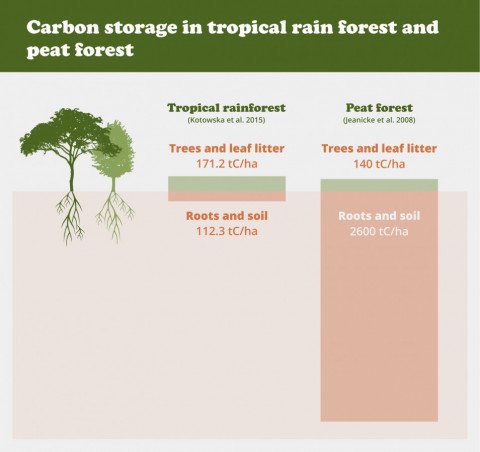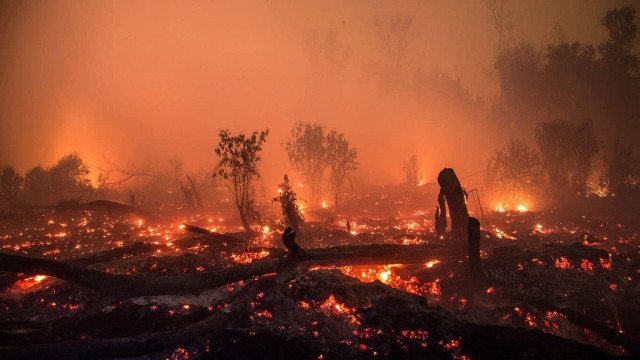
Featured News General News Editorials Interviews & Opinions Indonesia Water Journal Indonesia Water Portal Tuesday, 31 August 2021
Albeit covering only three percent of the world’s land surface, peatlands could store 550 billion tonnes of carbon. It is twice as much as the forests do globally. Additionally, peatlands hold 10 percent of global freshwater resources, according to the International Mire Conservation Group and the International Peat Society.
It is clear that peatland restoration does not only serve to conserve the habitat for extensive species of flora and fauna, but also represents our efforts to mitigate climate change and keep freshwater resources for humanity.
To understand more about the fights to restore peatlands in Indonesia—which accounted for 36 percent of the global tropical peatlands — we talked to I Nyoman Suryadiputra. With his limnology background and almost 40 years of on-the-ground experience, Nyoman served as the former Head of Yayasan Lahan Basah (YLBA) — a member of Wetlands International’s global network — and now becomes the Senior Advisor for the organisation’s programmes.
He is also part of the expert team of Peatland and Mangrove Restoration Agency (Badan Restorasi Gambut dan Mangrove or BRGM) and has been involved in multiple working groups, projects, and researches regarding peatlands in Indonesia.
Why peatlands restoration is crucial
Peatland is formed by organic materials, such as dead leaves and tree trunks, compiled in swampy or water-clogged conditions over thousands of years. This swampy condition slows down microbes in composing organic materials, causing the accumulation rate of organic materials higher than its decay rate and developing an ecosystem we called a peat swamp.”If peat swamp ecosystem is covered by forest, it becomes a peat swamp forest,” Nyoman explained. 
A watery red carpet covers the Sebangau peat swamp forest in Indonesian Borneo (Photo by Borneo Nature Foundation).
Based on research from Wetlands International (2005), Indonesia is estimated to have 20.6 million hectares of peatlands covering 10.8 percent of the Indonesian land area.
In 2011, the Centre of Agricultural Land Research and Development (Balai Besar Litbang Sumberdaya Lahan Pertanian) and the Soil Research Institute (Balai Penelitian Tanah) estimated that Indonesia has 14.91 million hectares of peatland. 43 percent of which are located in Sumatera Island, while the other 32 and 25 percent lie in Kalimantan and Papua Islands.
Peatland is well-known for its capability to store a vast amount of carbon and water. Indonesia’s peatlands themselves could hold 57 billion tonnes of carbon and almost 10 times of carbon storage per hectare compared to the country’s rainforests. Research showed that peat forests in Indonesia store 2,740 tonnes of carbon per hectare above and below ground, while rain forests in Indonesia store 283.5 tonnes of carbon per hectare in total.
Besides, peatlands could also act as a good water manager. During the rainy season, this spongy ecosystem helps to withstand floods, while in the dry season, it can release water to cope with droughts. With its hygroscopic characteristics, peat can hold water at up to 8.5 times its dry weight, meaning 1 gram of peat could hold up to 8.5 grams of water.
“Restoring peatland is not only for mitigating climate change but also for saving water. When peatlands are damaged and losing their spongy characteristics, we might lose one of the freshwater resources,” Nyoman emphasised.
Not to mention, peatlands host unique species of flora and fauna. According to the World Wildlife Fund, peatlands are home to 35 species of mammalia, 150 species of birds, and 34 species of fishes. Some of which are endemic and protected, such as Sinyulong crocodiles (Tomistoma schlegelii), Sumatran tigers (Panthera tigris sumatrae), and sun bears (Helarctos malayanus). Likewise, peatland is a flora-rich ecosystem, enabling ramin (Gonystylus Bancanus), jelutung rawa (Dyera Costulata), and punak (Tetramerista Glabra) to grow and live. The ramin tree is a famous commodity considered luxury timber for furniture in Kalimantan’s and Sumatran peatlands.
Sinyulong crocodile (left), Sumatran tiger (middle), and ramin tree (right) are among species of flora and fauna found in Indonesia’s peatlands (Photo by Junkyardsparkle, Zoological Society of London & WanaSwara)
Drainage canals: the beginning of a catastrophic cycle
Growing pressure on arable land for agricultural and industrial plantations – such as oil palm and acacia – has led to severe function shift of peatlands and deforestation over the last decades. As of 2015, only seven percent of peat swamp forests are still pristine in Sumatra and Kalimantan. Research also found that Indonesia lost this ecosystem in both forementioned islands at a concerning rate of 2.6 percent annually between 2007 and 2015.Sadly, palm oil and acacia are not able to live in paludiculture or categorized as cultivation plants able to live in wet peatlands without drainage. Thus, planting non-paludiculture plants in wet peatlands will require the construction of drainage canals to drain the water, which then cancels water as an inhibitor for microbes to decompose organic materials. As a result, when organic materials decay, peatlands also shrink and cause subsidence.”Building drainage canal begins the problems in peatlands, which then creates a complex cycle of challenges for peatlands,” he added. 
Draining peatlands will also lead the carbon storage in the peat to be released into the air. According to World Resources Institute, draining one hectare of tropical peatlands will release 55 tonnes of carbon dioxide per year or equivalent to burning over 6,000 gallons of gasoline.
Dry peatland is more prone to fire, unintentionally and intentionally. If peatlands are burnt, they emit up to 10 times more methane than any type of soil, where methane is also considered 21 times more dangerous than carbon dioxide emission. It can be concluded that the impact of peat fires is up to 200 times higher than forest fires on global warming.
Throughout all forest and peat fires in Indonesia, the 2015 fire was one of the worst. Over 2.6 million hectares of forest, peat and other land were burned in 2015, equivalent to 4.5 times the size of Bali island. The daily emission from fires in October 2015 exceeded the emissions from the entire US economy or over 15.95 million tonnes of CO2 emissions per day. It also caused half a million people hospitalised due to acute respiratory infections. World Bank estimated the 2015 fires cost USD 16 billion to Indonesia’s economy, more than 2 times the damage and losses from the 2004 tsunami, and equal to 1.8% of Indonesia’s GDP.
Burning peatland is seen in Palangkaraya, Central Kalimantan. Uncontrolled peat fires can spread for kilometers underground and by air, causing deadly smog. In 2015, this resulted in one of the greatest environmental disasters of the 21st century. (Photo by JP/Björn Vaughn)
Strategy: Rewetting, revegetation, and revitalisation
Peat Restoration is an effort to restore degraded peat ecosystems , then their hydrological conditions, structures, and functions. After the national catastrophe in 2015, the Peatland Restoration Agency (Badan Restorasi Gambut, which then becomes BRGM in 2021) was established in January 2016 and came up with the 3R strategy to restore peatlands in Indonesia: re-wetting, revegetation, and revitalization.
“We cannot switch the order of 3R because peatlands are naturally wetlands. So, the first main focus is re-wetting,” Nyoman stated.
Re-wetting is the effort to keep peatlands in wet condition. By doing so, it is hoped that the groundwater level will rise so that the peatland could provide back its ecosystem service, and the moisture will increase to inhibit fires in the dry seasons. There are three ways to achieve this:
- Construction of water retaining structures, such as canal blocking
- Dump the open canals with earth
- Drilling well construction
Canal blocking with paperbark tree (Photo by BRGM)
The second R is revegetation. Revegetation acts to restore peatland ecosystems through planting native plant species or with other types of plants that are adaptive to wetlands and have economic value in cultivation functions, called paludiculture, such as jelutung, ramin, and gaharu trees. Revegetation will maintain the ecosystem’s sustainability, protect the peat against erosion, and provide economic value for local communities living near the peatland ecosystem.
Lastly, the third R is revitalisation which aims to improve the welfare and livelihood of local communities near peatlands. The activities will be involving the community in agriculture, fisheries, and eco-tourism to increase their welfare.
World Resources Institute found that Indonesia could avoid up to 7.8 billion tonnes of carbon dioxide caused by peatland degradation and drainage by 2030. It is equivalent to the annual greenhouse gasses emitted by the United States, although the result will depend on the successful restoration of hydrological unity within plantation concessions.
Sustaining peatland restoration and working together
Although peatland restoration remains a challenge for all stakeholders, Nyoman suggested that peatland be managed simultaneously. “The management of Peat Hydrological Unit (Kesatuan Hidrologi Gambut) is complex, and oftentimes, one peat hydrological unit is managed by several governments and used for different functions. Thus, peat hydrological unit could not be managed in a silo.”
“All stakeholders, including governments, private companies owning concession in peatland area, local communities, and global communities are all responsible to peatland destruction. And we should have the same commitment (by working with all the stakeholders) to restore peatland,” he concluded.
Written by Rizki Ramadhan Prayitno (The Water Agency)
Tags: Peatland peatland restoration BRGM climate change water conservation














